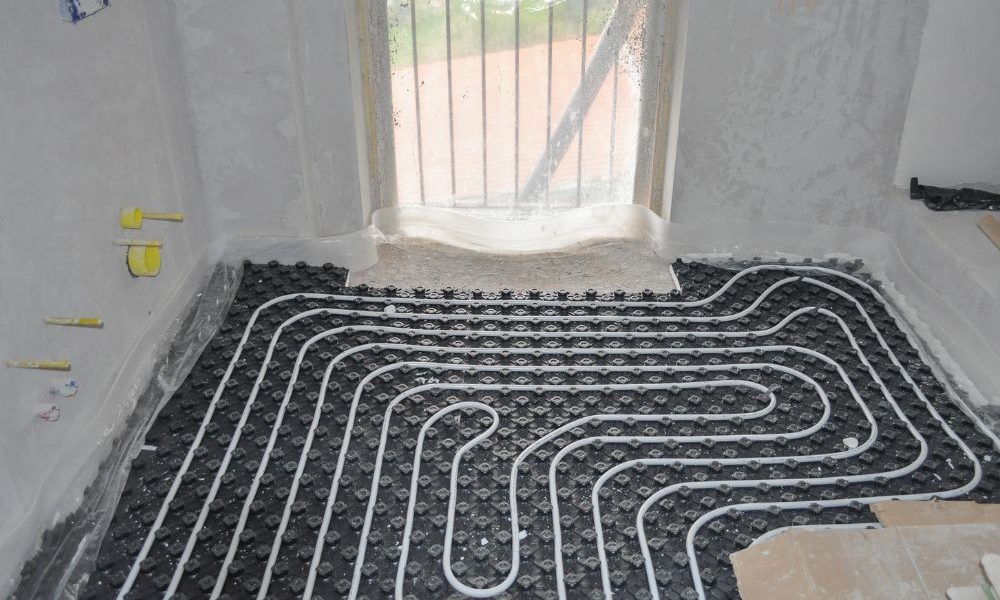Imagine stepping out of bed on a chilly morning and feeling the warmth of your floor gently heating your feet. Radiant heating under tile can make this a reality, transforming your home into a cozy haven even during the coldest days. This article will explore the benefits, installation process, and maintenance tips for radiant floor heating, helping you understand why it’s a luxurious and practical choice for any homeowner.
The Warmth of Radiant Heating
Radiant floor heating is an underfloor heating system that provides heat directly to the floor surface. It’s known for its efficiency and comfort, making it a popular choice for modern homes. Kerrie Kelly, Interior Designer and Founder of Kerrie Kelly Design Lab, beautifully captures the essence of radiant heating, saying, “Radiant floor heating under tile is the most luxurious way to warm your home. It’s like walking on sunshine, even on the coldest days” (Houzz).
Benefits of Radiant Floor Heating
- Comfort: Radiant floor heating delivers consistent warmth, eliminating cold spots. The heat rises evenly, creating a comfortable environment from the ground up.
- Energy Efficiency: Radiant heating systems are more efficient than traditional forced-air systems. Peter Biondo, HVAC Expert and Owner of Biondo Plumbing & Heating, notes, “Radiant floor heating is incredibly energy efficient. It heats the objects in a room directly, rather than the air, so you can maintain a comfortable temperature with a lower thermostat setting” (This Old House).
- Health Benefits: Unlike forced-air systems, radiant heating doesn’t circulate dust and allergens. Dr. Alan Greene, Pediatrician and Author, highlights, “The gentle, even heat of radiant floor heating is not only comfortable but also healthier. It doesn’t circulate dust and allergens like forced-air systems, making it ideal for people with allergies or respiratory sensitivities” (DrGreene.com).
- Aesthetic Appeal: Radiant heating is hidden beneath the floor, freeing up wall space and eliminating the need for unsightly radiators or vents.
- Increased Home Value: Adding radiant floor heating can boost your home’s resale value. Kermit Baker, Chief Economist at the American Institute of Architects, states, “Radiant floor heating can increase the value of your home. It’s a sought-after feature that many homebuyers are willing to pay a premium for” (Realtor Magazine).
Ideal Flooring for Radiant Heating
Tile is an excellent choice for radiant floor heating due to its heat-conducting properties. Dan DiClerico, Home Improvement Expert, explains, “Tile is the perfect partner for radiant floor heating. It’s a great conductor of heat, so it warms up quickly and evenly, and it retains heat well, keeping your floors warm even after the system cycles off” (Consumer Reports).
Types of Tiles Suitable for Radiant Heating
- Ceramic and Porcelain Tiles: These materials are durable, heat-conductive, and available in various styles and colors, making them a popular choice for bathrooms and kitchens.
- Stone Tiles: Natural stone tiles, such as marble and slate, are excellent heat conductors and add a touch of luxury to any room. They retain heat well, making them perfect for radiant heating systems.
Installation Process
Installing radiant floor heating under tile can be a DIY project for those with some home improvement experience, but hiring a professional ensures the job is done correctly. Here’s a general overview of the installation process:
- Preparation: Clear the floor and ensure it’s clean and level. Any debris or uneven surfaces can affect the heating system’s performance.
- Insulation: Lay down a layer of insulation to prevent heat loss downward and improve efficiency.
- Heating Elements: Depending on the system, install either electric heating mats or hydronic tubing. Electric mats are easier for DIY installations, while hydronic systems, which use heated water, are typically installed by professionals.
- Thermostat: Install a thermostat to control the heating system. This allows you to set and maintain a comfortable temperature.
- Tile Installation: Once the heating elements are in place, install the tiles as usual. Use thin-set mortar to adhere the tiles to the subfloor.
- Grouting and Sealing: After the tiles are set, apply grout and seal the tiles to protect against moisture and stains.
Personal Anecdote
When I decided to install radiant floor heating in my bathroom, I was initially overwhelmed by the process. However, I found that preparing properly and following step-by-step guides made the installation manageable. The results were worth it—stepping onto warm tiles on a cold morning is pure bliss.
Maintenance Tips
Maintaining a radiant heating system is relatively simple, but a few key practices can ensure it continues to function efficiently:
- Regular Inspections: Periodically check the thermostat and heating elements for any signs of wear or damage.
- Tile Care: Keep the tiles clean and sealed to prevent moisture from seeping through to the heating elements.
- Professional Servicing: Schedule regular maintenance checks with a professional, especially for hydronic systems, to ensure everything is working correctly.
Energy Efficiency and Cost Savings
Radiant floor heating systems are known for their energy efficiency. They provide even heat distribution, allowing homeowners to set the thermostat lower while maintaining a comfortable environment. According to a study published in the journal Building and Environment, radiant floor heating can reduce energy consumption by up to 30% compared to traditional forced-air systems.
Cost Considerations
While the initial installation cost of radiant floor heating can be higher than other heating systems, the long-term savings on energy bills and the increased home value can offset this expense. Additionally, the durability of radiant heating systems means fewer repairs and replacements over time.
Health and Environmental Benefits
Radiant floor heating not only enhances comfort but also offers health and environmental benefits. A study published in the International Journal of Indoor Environment and Health found that radiant floor heating systems improve indoor air quality by reducing dust mites and allergens, which can help reduce asthma and allergy symptoms.
Sustainable Choice
Choosing radiant floor heating aligns with sustainable living practices. These systems are energy-efficient, and when combined with eco-friendly tiles, they contribute to a greener home.
Conclusion
Radiant floor heating under tile is a luxurious and practical upgrade for any home. It offers consistent warmth, energy efficiency, and health benefits, making it an excellent investment. Whether you’re renovating your bathroom, kitchen, or any other room, radiant heating can transform your space into a cozy, comfortable retreat.
By understanding the benefits, installation process, and maintenance tips, you can make an informed decision about incorporating radiant floor heating into your home. As Mark Ehlen, Vice President of Radiant Professionals Alliance, puts it, “Heated floors are the ultimate luxury for your feet. They provide a gentle, consistent warmth that radiates throughout the entire room” (Floor Covering Weekly).
So, why wait? Warm up your home and your toes with radiant floor heating and experience the ultimate in comfort and style.




